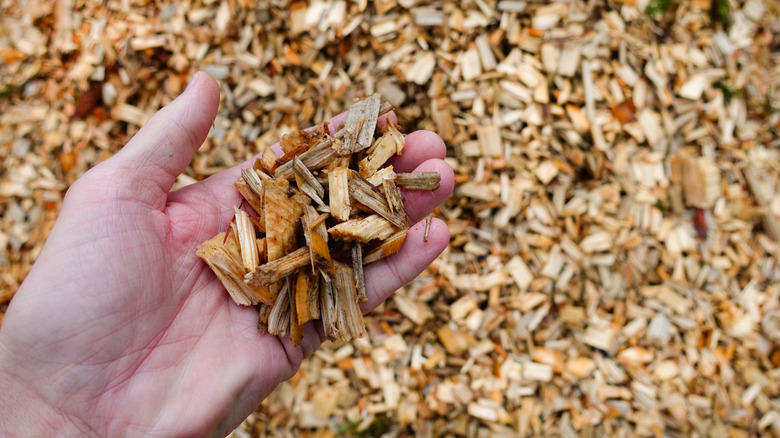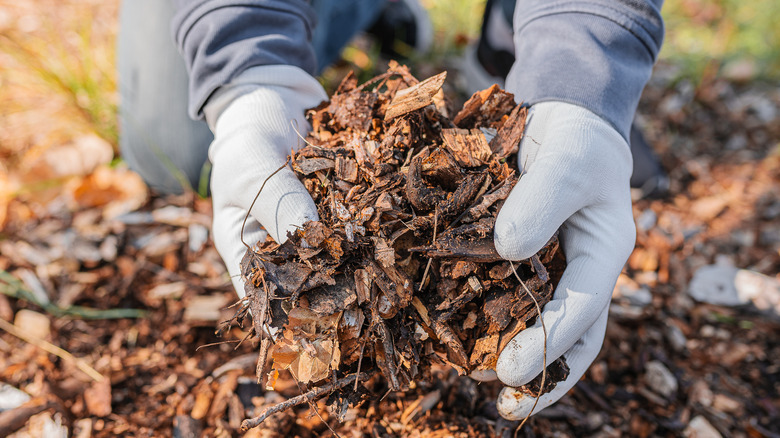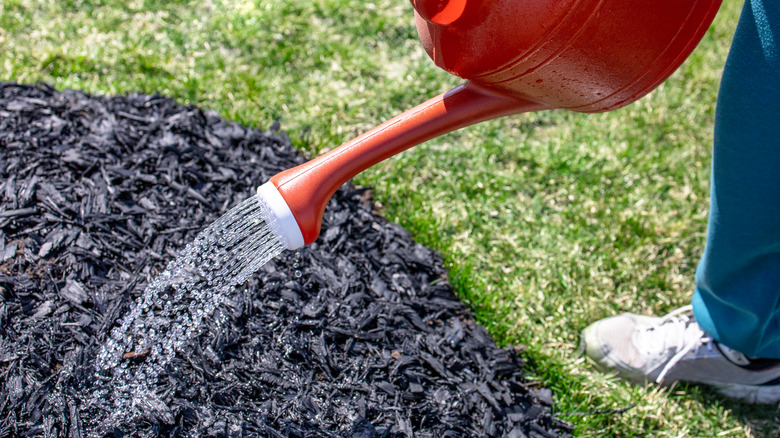How To Repurpose Wood Chips That Have Started To Get Moldy
In addition to being a good option for paths and walkways, wood chips are an eco-friendly mulch option for your garden and flower beds. Undyed, untreated wood is a sustainable material that breaks down, providing nutrients to enrich soil over time. However, depending on the size of the wood chips and the type of wood, the chips can get moldy if exposed to excessive moisture. The fungal growth can change the wood's color, making it unsightly for a top mulch layer. There may also be an unpleasant odor, depending on the type of mold present. However, moldy wood chips can be repurposed to make layered lasagna garden beds.
While many molds and fungi are beneficial, exposure to some molds can cause health impacts. This can vary depending on the type of mold present. Moving moldy mulch from one place to another can aerosolize the molds, possibly causing illness in people who are sensitive to them. Wear a respirator mask while shoveling large amounts of moldy wood chips, just to be on the safe side.
Fungi are essential to breaking down wood chips, and most kinds of fungi you'll see aren't dangerous to trees or other plants, and should be left alone. Some commonly seen mulch fungi like stinkhorn fungi and bird's nest fungi don't pose a threat, but you might want to dispose of spore-shooting artillery fungus. If you have children or pets, however, keep them away from areas with mushrooms — or remove that type of fungi completely.
Using moldy wood chips for layered garden beds
Using moldy wood chips as the bottom layer of a hügelkultur or lasagna garden is a great way to upcycle them. The mold encourages the growth of other beneficial microorganisms in the soil. Add other natural materials over the moldy wood chips allows them to eventually create a compost-rich mix for planting. Over time, the wood chips and plant materials will break down, providing a nice organic underlayer to the garden bed, which should then be covered with fresh soil before planting.
A suggested order of layering for your garden bed might look like this. Start with cardboard or layers of burlap over the intended location. Then add the moldy wood chips. Over this, you can lay some small sticks, pine needles, leaves, grass clippings, weeds, or other plant material. Make sure you're not adding invasive plants you should never grow, such as Japanese knotweed, bittersweet, Virginia creeper, lily of the valley, or bishop's weed.
While chemically treated and dyed wood mulches can also grow mold, it's not recommended to use these in a layered garden, because the chemicals may leach into the soil. Try to only use natural, untreated materials in this style of layer gardening. If your dyed mulch grows moldy, you can try the vinegar method described below, or simply sort the moldy chips from the healthy ones and remove them. Sunny weather will sometimes dry out mold after a few days, as mold needs moisture to grow.
Other ways to upcycle and use moldy wood chips
Another way to repurpose wood chips that have grown unsightly mold is to utilize them in a space where they're not highly visible or noticeable. Putting a mulch layer beneath hedges or around the base of shrubs is a great way to conserve moisture and help enrich soil. You can also place the moldy wood chips around trees, beneath open stairs where weeds tend to grow, or along a wooden fence to help prevent weeds from spreading to or from a neighboring property.
You can also upcycle your moldy wood chips by adding a fresh layer of wood chips over the top. This will cover the moldy layer and freshen up the look of your mulch. This will also help cover up the odor of mold, if there is one. Watch the weather forecast before doing this — make sure there will be a few days of dry or sunny weather before adding fresh mulch to help dry out any mold spores and prevent them from spreading to the fresh layer.
Wood mulches could be the best type of mulch for your garden, but there are pros (it's natural and affordable) and cons (possible mold and fungal growth) to consider. While moldy wood chips are generally not harmful, they can affect your garden's beauty. Fortunately, there are ways to mitigate mold and recycle affected materials.


